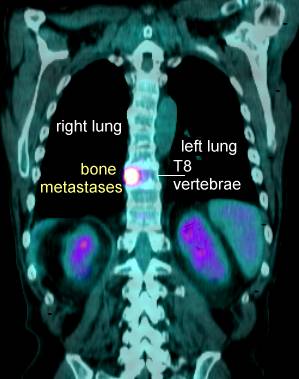A systematic overview of radiation
therapy effects in skeletal metastases.
Falkmer U,
Acta Oncol. 2003;42(5-6):620-33
A systematic review of radiation
therapy trials in several tumour types was performed by The Swedish
Council of Technology Assessment in Health Care (SBU). The procedures for
evaluation of the scientific literature are described separately (Acta
Oncol 2003; 42: 357-365). This synthesis of the literature on radiation
therapy for skeletal metastases is based on data from 16 randomized
trials. Moreover, data from 20 prospective studies, 5 retrospective
studies and 22 other articles were used. A total of 63 scientific articles
are included, involving 8051 patients. The results were compared with
those of a similar overview from 1996 including 13,054 patients. The
conclusions reached can be summarized as follows:
Irradiation of skeletal metastases
is, with few exceptions, a palliative treatment. There is strong evidence
that radiotherapy of skeletal metastases gives an overall (complete and
partial pain relief) in more than 80% of patients. There is strong
evidence that the duration of pain relief in at least 50% of patients
lasts for > or = 6 months. There is convincing evidence that pain relief,
in terms of degree and duration, does not depend on the fractionation
schedules applied. Irrespective of the fractionation schedule used
at irradiation, the number of later complications, such as spinal cord
compression or pathological fractures, at the index fields are low. There
are some data showing that the difference in cost between single and
multifraction treatment is small. However, these data do not permit any
firm conclusions to be drawn. Several reports indicate that early
diagnosis and early therapy of spinal cord compression are the two most
important predictors of a favourable clinical outcome after radiotherapy.
However, no controlled studies have been undertaken. When the diagnosis of
spinal cord compression is late, a favourable outcome might depend on the
radio-responsiveness of the tumour. The documentation is weak and no
conclusions can be drawn. There is some evidence that a small proportion
of totally paralytic patients can regain walking function after
radiotherapy. There is strong
evidence that the
radionuclides 89Sr and
153Sm are efficient when they are used as a systemic treatment of
generalized bone pain due to metastasis from carcinomas of the prostate
and breast. Overall bone pain relief occurs in about 60-80% of patients
with a median response duration of 2-4 months. There is strong evidence
that intravenous treatment with bisphosphonates
in patients with myeloma and osteolytic
bone metastasis due to carcinoma of the breast significantly decreases the
number of skeleton-related events and bone pain. |
